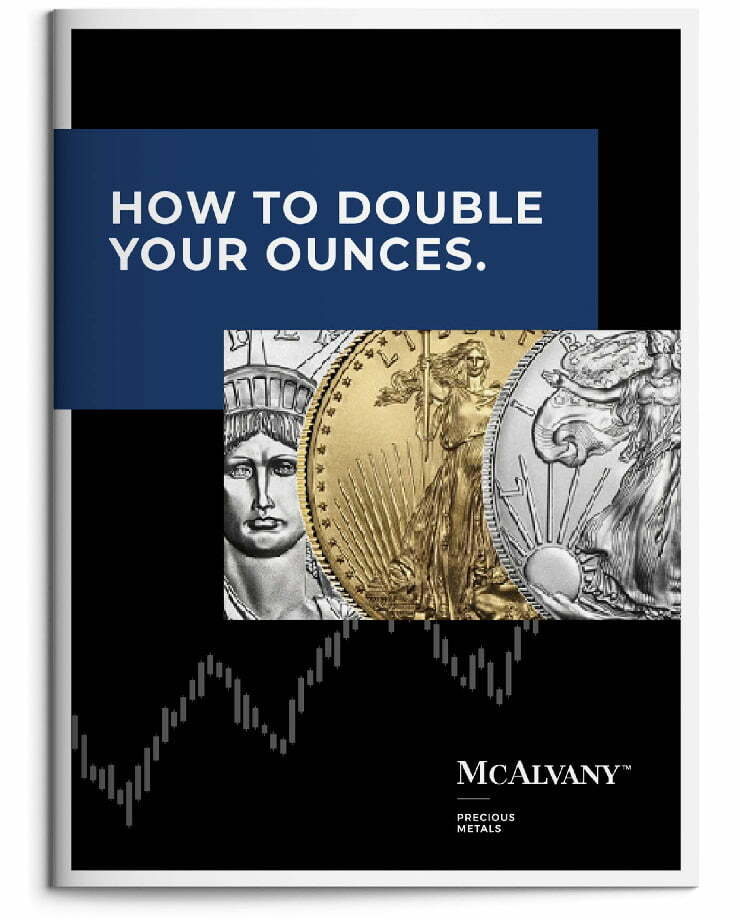Podcast: Play in new window
- Silver Mining Stocks, Gold ETF’s Now Confirming Higher Gold Prices
- MAG 7 Mania Consumes 31% Of Total U.S. Stock Market
- Verbal Debate Shouldn’t End With A Bullet
David: “Margin debt rose 3.6% in August to a new record high of 1.06 trillion. Remember, when you’re so confident in your portfolio allocations that you borrow from the house— So capital is pouring into risk assets, margin debt continues to skyrocket. Credit spreads show zero signs of stress. As an example, investment grade spreads to Treasuries are at levels we haven’t seen since June of 1998. Everyone is happy until of course no one is happy.” —David McAlvany
* * *
Kevin: Welcome to the McAlvany Weekly Commentary,. I’m Kevin Orrick along with David McAlvany.
David, momentum is something that we’ve talked about a lot with, say, the Mag 7 stocks and even cryptocurrency, momentum trades where all of a sudden people are starting to show up just based on the fact that they’re hearing other people are making money. The gold market, do we have momentum?
David: Momentum is in the gold market. We broke out above a 10-year consolidation in 2024, above the 2,200 level, and last month we broke out of a four-and-a-half-month consolidation. It had every opportunity to correct.
Kevin: And we didn’t get it.
David: Given a plethora of macroeconomic factors, it has not done so. So the price is on the move. We reached 3,700 an ounce on Tuesday, and of course this is just ahead of the Fed meeting and a presumed 25 basis point cut. Now there’s nearly an 80% probability of a second cut in October for a total 50 basis points. And as we discussed in the spring of this year, a 10-year consolidation and a breakout of that particular chart pattern suggests seven to eight thousand is a highly probable end point for the gold price.
Kevin: And you were talking, that has to do with a cup and a handle pattern, right?
David: That’s right. Obviously, we’re not there yet. I would not sell at these levels. I would certainly hold all metal and metal-related assets. Trim, if you like. Certainly you can expect to see some further consolidation and correction. Prices are volatile in both directions regardless of the asset in question, but I would hold all metals-related assets. And again, is this the time to abandon ship? No. I think things are getting interesting.
On the other hand, we have humble silver, $42.85 cents. It remains $6 below its nominal all time highs. $50 by the year-end or by the end of the quarter. Whenever it is, it’s coming soon. And that’s just the way that silver tends to do things. The ratio to gold will be in the 60s before long.
Kevin: Okay, so we’re in the 80s now. We should be in the 60s before long. So in other words, 60 ounces of silver would buy an ounce of gold. But several times in my career, Dave, we’ve seen 31 to 1. What do you think?
David: Yeah, it remains to be seen if we get back into the 30 to 1 range. We had that most recently in 2011. That would not surprise me. I’ll be exchanging silver for gold at much higher nominal prices, but getting better than double the gold ounces, which is the equivalent of paying half the going rate at that point.
Kevin: Right.
David: Does that make sense?
Kevin: Oh, absolutely. I’ve done it before.
David: So I want to compound ounces in the context of a metals portfolio. The long-term trend is very much in place. Prices are expensive, but the asset class is largely undiscovered by your generalist investor—and by your professional investor, as we’ll see.
Kevin: You were looking for a couple of confirmations for the gold market earlier in the year. You had mentioned that you wanted to look at gold stocks and see what that was looking like. You wanted to look at what the ETF buying was looking like, and you also wanted to look at silver. When silver started to outperform gold, that was a confirmation. So where are we on those confirmations?
David: Yeah. So looking for confirmation of a bullish trend and a breakout earlier this year, we wanted to see a variety of factors fall into place. Silver needed to step up its pace of gains relative to gold, and it’s done so, 41% year-to-date for gold, 48% for silver year-to-date. That’s done.
Kevin: So silver’s outperforming gold at this point.
David: Yep. We wanted to see the miners shift from underperforming bullion to first matching and then ultimately exceeding the performance of bullion.
Kevin: And that’s been dramatic.
David: Again, 41% for gold. And if you look at either GDX or XAU, HUI, Europe, roughly 105%.
Kevin: And those are the gold indexes that you watch?
David: That’s correct. And last, we wanted to see a pickup in Western acquisitions of the metals via the exchange traded funds. The silver ETFs have now had seven consecutive months of gains, and gold ETFs, four months with an uptick of nearly 40 billion in total assets, 10 coming from Asia, 10 from Europe, 20 from the US most recently. So the pace of acquisition in the ETFs is picking up. Holdings in gold ETFs are now at 3,692 tons. That is still 6% below the record set in November of 2020 at 3,929 tons. So yes, I think it’s fair to say what we wanted to see as evidence of a continuing trend, we have seen. The long-term trend is very much in place.
Kevin: I think it’s wise for us to maybe look at just how thin this market really is. When a person owns physical precious metals— Going back to 2008 when we had the global financial crisis, Dave, we couldn’t get metal. I mean, if you didn’t already own it, if you weren’t already sitting on it, we could get just little bits. How much were we able to actually get per day? We had just a fraction of what our business was.
David: That’s right. We were limited to one kilo bar per day per client.
Kevin: 32.15 ounces.
David: And that was for immediate delivery. If you wanted to wait anywhere from three to six months, then you didn’t have to pay premiums. Otherwise, we saw a transition in the conversation. It went from what is the price? to what is available?, and we have not seen that. Last week I had a variety of conversations with vaulting providers all over the world. An often repeated market comparison was between the value of gold and the value of global financial markets, sort of cumulative wealth. Admittedly, it’s not a precise number, but we can get pretty close. Gold is now a $25.5 trillion asset class.
Kevin: So when you’re talking 25 trillion, that’s all the gold that’s ever been mined.
David: That’s right. So 3,700 times roughly 216,000 tons. So $3,700 per ounce, which sounds like a lot until you compare it to a short list of other assets. Global debt markets tally to approximately 345 trillion.
Kevin: And there’s 25 trillion in gold ever.
David: The 345 includes bank lending. Global equities tally to 127 trillion. Global real estate assets, they estimate roughly 400 trillion. Privately held businesses, which were really impossible to get a precise number, but McKinsey a few years back estimated 70 trillion. I’m going to call it $80 trillion. You add all of those together, and—recognizing this is an imprecise exercise—you have in the range of $977 trillion in assets.
Kevin: So you could round that to a quadrillion, basically.
David: Trillion. Oh yeah, you’re right.
Kevin: Yeah. Quadrillion in assets, just close to it.
David: That’s right. I’m not used to that. That’s a—
Kevin: 977 trillion total, what we’re talking about is the fraction of gold to that, all the gold ever mined in history right now at current market price.
David: Yep.
Kevin: It’s about 25 trillion.
David: 25.5 divided by 977, you get about 2.6%. And gold has been approximately 2% of global assets on average historically. Sometimes it’s less, sometimes it’s more. The highest percentage gold has ever been is between 5% and 8%, 5% in the 1960s. I think it was the last time we had it there.
We may have bored you to tears last week talking about numerators and denominators, but the increase as a percentage of global assets can come from either a shrinkage in the value of that composite wealth number or from an increase in the ounce price—or both, of course. So 5% was the number in the ’60s. I think that is reasonable to get back to.
Kevin: And we’re 2.6 at this point.
David: That’s right.
Kevin: Okay. But that’s not really even fair, is it? Because do we actually have access to all $25 trillion worth of gold that’s ever been mined?
David: Well, and this is the point. You have gold, which for the economist would fit the category of supply inelastic. And for something to be supply inelastic, you can’t, like Doritos, just print more.
Kevin: Print more. Yeah, munch more.
David: Munch more. We’ll make them.
Kevin: Yeah. Well, make as we make as many as you want.
David: Yeah. So the qualifier, if you count the ounces in the form of coins, bars, jewelry, and central bank reserves—gold that is theoretically available for purchase—you have an even smaller market, about 40% of the total. And that’s according to World Gold Council research. That places it around 10.2 trillion at current prices, and then further assume central banks are not eager to trade out of their gold reserves. Then you have about 5 trillion in gold that is actually available. New mine supply at current prices, roughly 350 billion annually. That’s between 3,500 and 3,700 tons a year. So if you’re looking at annual mine supply, it’s roughly the market cap of Bank of America or Procter & Gamble.
Kevin: Well, and going back to all the gold that’s ever been mined worth 25 trillion, but what’s available is what you’re saying is maybe less than 5 trillion, which when you contrast that with almost a quadrillion dollars in global assets, you’re talking a little over a half a percent, aren’t you?
David: That’s right. And so we think that number can swell towards five, maybe as much as eight, but I think 5% is a good destination.
Kevin: Well, you talk about momentum, Dave, but we actually haven’t seen any panic buying right now. I’m not getting calls from people saying, “Gosh, gold is going up. I’ve got to buy some.” We know those days, and when they happen, you recognize them.
David: Usually, that is event driven. We have yet to see the panic button. Gold is wealth insurance, and people don’t see the need for insurance with asset prices bubbling higher. Sure, there is a disturbing macro backdrop, which includes public policy dysfunction, international relations dysfunction, a growing anti-dollar block—
Kevin: Yeah, the BRICS.
David: Yeah, exactly. —who would like to repudiate the older world order centered on US dollar hegemony. You’ve got a couple of global hot wars, you’ve got budgetary stress in almost every corner of the globe, given the quantities of debt. And of course, attached to that, the interest, the increase in interest costs on that debt.
Kevin: So they’re not panic buying right now.
David: Yeah. Investors are not panic buying. When they do, that’s when the conversation turns from what is the price? to what’s available?.
Kevin: Like back in 2008?
David: Yep. We’re not there yet. I’ll let you know when we are. I understand the needs that investors have to harvest gains, and we’ve had, certainly, clients call because they want to buy a house, they need to buy a car. There’s medical expenses. I would say that the macro backdrop is primed for the greatest rewards of physical metals ownership to be captured in the months and the years ahead.
Kevin: So when we talk about small percentages, there’s not a lot of gold out there relative to all the other financial assets. But let’s talk about the Mag 7 for a little while. I mean, the stocks right now that are dominating and actually taking the majority are just, what is it, five to seven stocks.
David: Yeah, exactly. And the percentage of the total—if you’re talking about that equity market capitalization globally, we mentioned 127 trillion globally—the Mag 7 account for 20 trillion, 19.66 trillion of that 127 in global market cap. If you just think about that, that’s nearly 16% of all value in the global equity markets is concentrated in—
Kevin: In seven stocks.
David: Seven US listed names.
Kevin: Wow.
David: There has never been a greater concentration ever. If there is a warning light flashing, that’s it. US equities count for about $63 trillion of that global value, 63 of the 127. But think about this, those seven names account for 31% of total US market cap. Again, it’s never been higher—
Kevin: Almost a third of the entire stock market is seven stocks, and here in the United States.
David: If we’ve said it once, we’ve said it a thousand times. Narrowing breadth or narrowing of participation in a market bull is a classic warning sign of momentum fading. We’re not necessarily at the end of the line, but we are getting close.
Kevin: Okay. So how long does momentum go? A lot of times, it can go a lot further than we think, but how long does it go?
David: Well, momentum runs until you run out of buyers.
Kevin: Okay.
David: The momentum flips then. So imagine a line of buyers that drives prices to higher levels. When the line thins out, what you have instead is a hypothetical line of sellers. If the narrative shifts, then the line shifts.
Kevin: Okay. But what I’m seeing is I’m not seeing a line in gold. I mean, we’re talking about momentum based on price and some of the indicators that you’re looking at, but I’m not looking at a line of people right now going, “Give me my gold.”
David: So that’s the contrast. We have a bull market in metals. We also have a bull market in equities.
Kevin: Right.
David: That line is thinning on the equity side, even while we’re still looking for a gathering of the masses to own some form of gold, whether it’s a proxy or a physical ounce.
Kevin: So the checklist that you’ve talked about, ETFs, the silver price actually outperforming gold, gold mining stocks all of a sudden kicking in. What we’re seeing is we are starting to see that public momentum shift, even if we don’t see a line.
David: Only at the front edge though. As it relates to gold, momentum runs until you run out of buyers, just like any other market. Gold is no different. And here, I would be encouraged as a metals owner. Earlier this year in a Bank of America survey of asset managers, 58% responded to the question, what is the most crowded trade today? Gold was the trade they thought was the most crowded.
Kevin: You’re kidding. They thought that was a crowded trade.
David: And yet the size of their allocations came in at 2.2%.
Kevin: And that’s a crowded trade.
David: Not yet.
Kevin: Yeah.
David: Not yet. The World Gold Council ran similar numbers not long ago, finding that of professional investors, a quarter of them had less than 1% in gold. Half of them had at least 1%, and then the other quarter, the remaining 25% of professional investors surveyed had an allocation of 3% or more.
Kevin: Well, and the individual investor, which is what we were talking about, definitely not yet.
David: Yeah. I’d say this is far from a crowded trade. Individual investors are a mixed bag. If you are a McAlvany, your percentage holdings help bring that average higher. If you’re a McAlvany—
Kevin: All generations of McAlvany. Yeah.
David: That’s right. If you are a McAlvany client, you remain in the minority. The Mag 7 is where the money is loading in.
Kevin: And I just wonder, though, on that Mag 7, what is really the driver right now? Is it AI? I mean, is AI really the dream that everyone thinks it’s going to be?
David: That’s the narrative, and panic buying will be the next leg up in the gold market as the generalist investor realizes that the AI narrative is empty. Just like the internet narrative was empty in 2000, 2001.
Kevin: And you’re not saying that AI doesn’t have a function or the internet doesn’t have a function, it’s just that everybody was investing 50 years of future profits into it.
David: Yeah. It’s to say that actually everything is changing because of AI, but profits and the promise of improved unit economics utilizing AI are both elusive at this point and disappointing. Is AI a game changer? Yes, it is, but not because it’s delivering outsized profits for the users of AI.
This, in many respects reminds me of the railroad craze in the 19th century. So much speculative capital chased the surge in rail capacity that, not surprisingly, it was overbuilt, leading to the panic of 1873. In just a few short years they added 35,000 miles of rail, and it was in some cases to places that weren’t populated yet. It was sort of betting on a future yet to arrive. The problem is, investor expectations of return in the interim before that future arrives are very real, and it can be very judgmental, very harsh. If they’re not satisfied, if their expectations aren’t met, there’s a price to pay.
Kevin: It reminds me of fiber optics. Remember fiber optics? They were going everywhere with fiber optics, and then all of a sudden, they found out they didn’t really need it.
David: A part of that was they figured out how to better package the data so they didn’t need as much capacity. So, go back to the panic of 1873, followed by depression. Within two years you had 18,000 businesses fail. Unemployment hit 14%.
Kevin: 14%, wow.
David: Yeah, if you think that’s a stretch, think about where we’re at today. Again, the narrative is strong in terms of the people believing it, in terms of the strength of passion behind it.
Kevin: People are still taking out a lot of debt to buy those stocks.
David: That’s the fascinating piece, is people are so confident, you could almost describe it as overconfident. What’s an indication of overconfidence in the market today? Margin debt rose 3.6% in August to a new record high of 1.06 trillion. Remember, when you’re so confident in your portfolio allocations that you borrow from the house to enhance those positions—
Kevin: Right. You want to get double out of your stocks or triple out of your stocks.
David: Own more than you can actually afford. So, capital is pouring into risk assets, margin debt continues to skyrocket. Credit spreads show zero signs of stress. As an example, investment grade spreads to Treasuries are at levels we haven’t seen since June of 1998.
Kevin: Nothing to worry about here.
David: Everyone is happy, until of course no one is happy. That is why bubbles are so dangerous. The narrative justifies a feeling, and it provides intellectual cover for what in the end ends up being flawed math.
And you can look and say, yeah, but we don’t have any real concerns in terms of recession. And I think that’s a fair point. Recession indicators like industrial production, non-farm employment, real retail sales—not just retail sales, but adjusted for inflation—and real personal income, they’re not signaling a downturn, but they are close, and that’s worth keeping in mind. Employment figures with the recent revisions are at year-over-year, currently at or below the levels that they were at at the start of 10 of the last 13 recessions. That’s going back to 1940. Industrial production is the oldest of those four indicators that are the triggers for what is officially a recession. Industrial production dates back to 1919. And when looking at current levels in terms of year-over-year percentage change, it’s lower than at the onset of 14 of 18 recessions covering a hundred-year period.
Kevin: We’re getting some indicators that recession is creeping in.
David: We’re close. Nothing that would trigger it, nothing that would signal it is here, but it’s worth keeping an eye on. Real retail sales is hanging in there, still positive after accounting for inflation, but not by a large margin. It’s up 2% year-over-year. Real personal income is flatlined. It’s been very volatile in recent years. You had it dip towards a negative 6% early in COVID, and then it popped to a positive 11%. This is real personal income. That’s post the stimulus. Now, we’re sitting at 1.6. Again, it’s hugging the line, so it’s to the good for now, but it is actually in a declining trend.
Kevin: So, yellow light, not red, right?
David: Correct. And that last figure excludes transfer receipts, things like Social Security, Medicare, Medicaid, unemployment assistance. You can look at the leading economic indicators or the leading economic index. It’s measured on a weekly basis, and that too is something that is used to signal a recession.
Kevin: What do they look at when they do that?
David: Corporate bond markets, Treasury bond markets, stock market, the labor market, the credit market as a composite, and the mortgage market, those six things. Three of the six are expanding. Currently, you’re at a plus 11.29 to the positive. Recessions are usually called when the number is 10, 11 points negative or more. So, we’re not there yet.
But look at how liquidity influences five of those six factors. If there’s liquidity in the market, the corporate bond market is happy. If there’s liquidity in the market, the Treasury bond market is happy. If there’s liquidity in the market, the stock market is happy. If there’s liquidity in the market, the credit markets and mortgage markets are happy. As long as the markets are awash in liquidity, recession is not a concern. But you trigger a contraction in liquidity, which could be event driven, and you can get there in a hurry.
Kevin: The likelihood of a recession over the next couple of years is growing, is what you’re saying.
David: Yeah, we’re just not there yet. The last one, that I didn’t emphasize, the labor market. This is where all of a sudden you begin to see intense pressure within the bond market, and I connect those two because the unsustainable aspect of debt is the interest payments. If you have a recession, you end up with a drop in tax receipts, and now the percentage of income to the government required to make payments on that debt as a percentage goes up dramatically. And we’ve already seen the trend in place. We started at 6%, I think that’s about five years ago. We’re now between 19 and 20%. You get a recession where tax receipts decline, guess what’s not going away? Your interest expense. And so, as a percentage of tax receipts, now all of a sudden you’ve got a big issue, to which the bond market responds, uh-oh. It’s that wily coyote moment in the bond market where prices drop and yields fly.
Kevin: And the 25 basis point cut first and then another 25 probably coming up in October. A lot of that has to do with the government not being able to pay the interest on their debt based on what you’re talking about. So, a drop in tax receipts, if we do have a recession, that does put an awful lot of pressure on short-term interest rates and the long bond. It’s almost like we’re in a corner at that point.
David: Yeah. And I think what’s underappreciated, we’ve got over 30% of all of our debt outstanding which gets rolled over this year, and it currently is at numbers that are uncomfortable for the Treasury department. So, the basic math is, let’s lower interest rates, the fed funds rate, let’s get control of the Fed. That’s what Trump wants. That’s what Bessent wants. If we control the Fed, we control the fed funds rate, we can lower interest rates.
The flaw in that is, they don’t control the entire yield curve. And we’re at a point in time where if there is a loss of credibility with the Fed, you could very well see long rates climb even while they’re lowering the fed funds rate, which would force them to roll over that 30% debt into short-dated paper, and now they’re living with the same problem that they’ve had since Yellen retired.
Kevin: And then you have to go back to strange ways of getting quantitative easing into the system.
David: Well, I think it sets up for the next few years seeing yield curve control as a principle way of managing our debt. When you bring in yield curve control, all of a sudden you don’t want to be a bond investor. And so, when you think about potential volatility in the stock market and the likelihood of yield curve control on the horizon, the classic move has been from stocks to bonds if you want to get out of harm’s way. So, the 60/40 portfolio—or the 40/60 if you invert it because you’re getting a little older and you want more fixed income exposure—just like we saw in 2022 and just like we saw in April of this last year, correlations move closer together and you really don’t have much diversification at all, which again—
Kevin: Well, and there’s your roll into gold.
David: I think that’s right. I think that’s where you see sophisticated investors saying, “I don’t know. I don’t think the Treasury is quite the bet they used to be.” If I’m going to de-risk my portfolio, come out of equities, where do I go that’s neutral? Where do I go where I understand the risks and I’m not subject to policy caprice?
Kevin: One of the things, Dave, that your family has stood for— I want to shift from economics for a moment, actually to just wrap this up. Your dad spoke the truth and wrote a newsletter speaking the truth, and you were raised in a household that basically said, “Whatever your basis of truth is, it needs to be sound.” There’s a C.S Lewis saying that all truth is ancient, and that really does seem to have a ring. A lot of times when someone says, “Well, I have a new truth,” it doesn’t turn out to be truth. But speaking the truth and not shooting at people should be the way that we converse. You were raised by a father who spoke the truth, but then you went on and you studied philosophy. With that in mind, Dave, because you had hopes that if you could understand how people think and how you can reason, you can actually reason with people. And so your thoughts, Dave, about this week.
David: When I started studying philosophy, my first introduction was to Plato. Probably not a surprise, but you read the dialogues. What is it? It’s a discussion of ideas and it’s a back and forth. It’s a conversation, and that conversation is contentious. There are different sides, different opinions, different views to the nature of reality and what we should base society upon. You had the student following Plato. You look at Aristotle’s writings, there’s disagreement. there’s a different road that he goes down. In many respects, the construction of the state, the basis of metaphysics, you’re talking about a completely different view of the world, and yet the student had respect for the teacher.
Kevin: Right. And you looked at Socrates, who the state ultimately killed because they didn’t like what he had to say. There’s a point where somebody dies.
David: Absolutely. One of the things that I did in college, we had a discussion group and it was based on the 102 essays, which were in Mortimer Adler’s book, The Great Books of the Western World. The 102 essays are the recurring themes that run throughout western culture and literature, and have been a part of a dialogue, a conversation that’s gone on for several thousand years. You’ve got differences of opinion, and it’s not just nuances and the details, but sometimes radically different opinions. And yet the dialogue continues, the conversation continues. It’s very interesting when you get to a point where someone is so convinced that they have the truth they’re not able to engage in conversation any longer. They possess it.
Kevin: They just want to kill the adversary.
David: They possess it. They own it. It’s theirs. Or maybe they don’t care about truth the way someone else does, and it’s just a means of appropriating power. That I think is more and more the case where dialogue is not the point, and dialogue is not an option.
I will always push for it, and I’ll always engage with dialogue because I love ideas and I love the conversation. I love the conversation that’s gone on for 3,000 years, and I love the differences of opinion. I love that we are moving closer and closer to understanding the nature of reality.
As you said, maybe it’s not we’re moving closer and closer, but if Lewis was right, all truth is ancient and we’re just in the process of rediscovery. We need humility to accomplish that. We need an earnest desire. We need a heavy dose of humility to be open to being wrong. Who wants to be living their life according to a bad set of ideas? Does anyone?
Kevin: Well, I’ll just quote something that Charlie Kirk said to his employees numerous times. He says, “When conversations stop happening, when individuals become wordless, that’s when violence begins. If you do one thing today, make it be with passion. With conviction, stand up for your friends, stand up for your beliefs, and speak loudly. Even if your voice shakes, your words have meaning, your values have purpose. Never forget that.”
David: I agree with that. One of the things that I discovered leaving college with a degree in philosophy is that there weren’t as many people interested in the world of ideas as I thought there were. A small cohort of philosophy students, you get together and the sun sets and you’re smoking a pipe and you’re thinking deep thoughts and having intriguing conversations, probably way out over the tips of your skis most of the time. Not really understanding what you’re talking about, but you make your best efforts.
There’s the vast majority of people that don’t care about ideas, and I think there is an issue of pre-commitment to worldviews without caring about logic, without caring about reason, without caring about truth. This gets to something that is vital for our culture. It’s not in the minds that we need change. It’s in the human heart that needs change.
Kevin: That’s right.
David: There has to be some form of openness within the human heart to receive, to be impacted by, to be ultimately transformed by truth. To conform your life to truth as opposed to conforming the world to your truths is very, very different. I think it’s an issue of the human heart that needs to be softened prior to any of those things.
I respect Charlie’s efforts. I think, in some sense, they were naive in that it requires a predisposition and openness, a posture of humility to say, “now what are you trying to tell me here? What am I supposed to take from this? Now if we disagree, is it possible that you have some insight in the nature of reality that I don’t have?” That is a disposition that is not as common in today’s culture. That, I think, we should hope for and lean into.
Kevin: Well, it’s a sad thing when someone shoots somebody for what they’re speaking truth, but even if he was naive, his truth has gotten out to the world at this point based on the martyrdom that he had for the truth.
David: Let me add something to what I just said about Charlie Kirk. I don’t think he was naive in his efforts. I think there is two audiences, one which is receptive, and there is an openness amongst a certain age group and demographic to ideas and clarity of speaking. I think he had a profound impact on them.
I think what I’m getting at is what Chesterton said years ago, “You can’t reason someone out of something they didn’t reason themselves into.” There is another group who can’t be reached with logic, can’t be reached with reason, and who don’t appreciate dialogue. That is the sticking spot. That’s the greatest challenge of our age is creating meaningful dialogue with people who won’t tolerate it.
* * *
You’ve been listening to the McAlvany Weekly Commentary. I’m Kevin Orrick along with David McAlvany. You can find us at mcalvany.com and you can call us at (800) 525-9556.
This has been the McAlvany Weekly Commentary. The views expressed should not be considered to be a solicitation or a recommendation for your investment portfolio. You should consult a professional financial advisor to assess your suitability for risk and investment. Join us again next week for a new edition of the McAlvany Weekly Commentary.
















